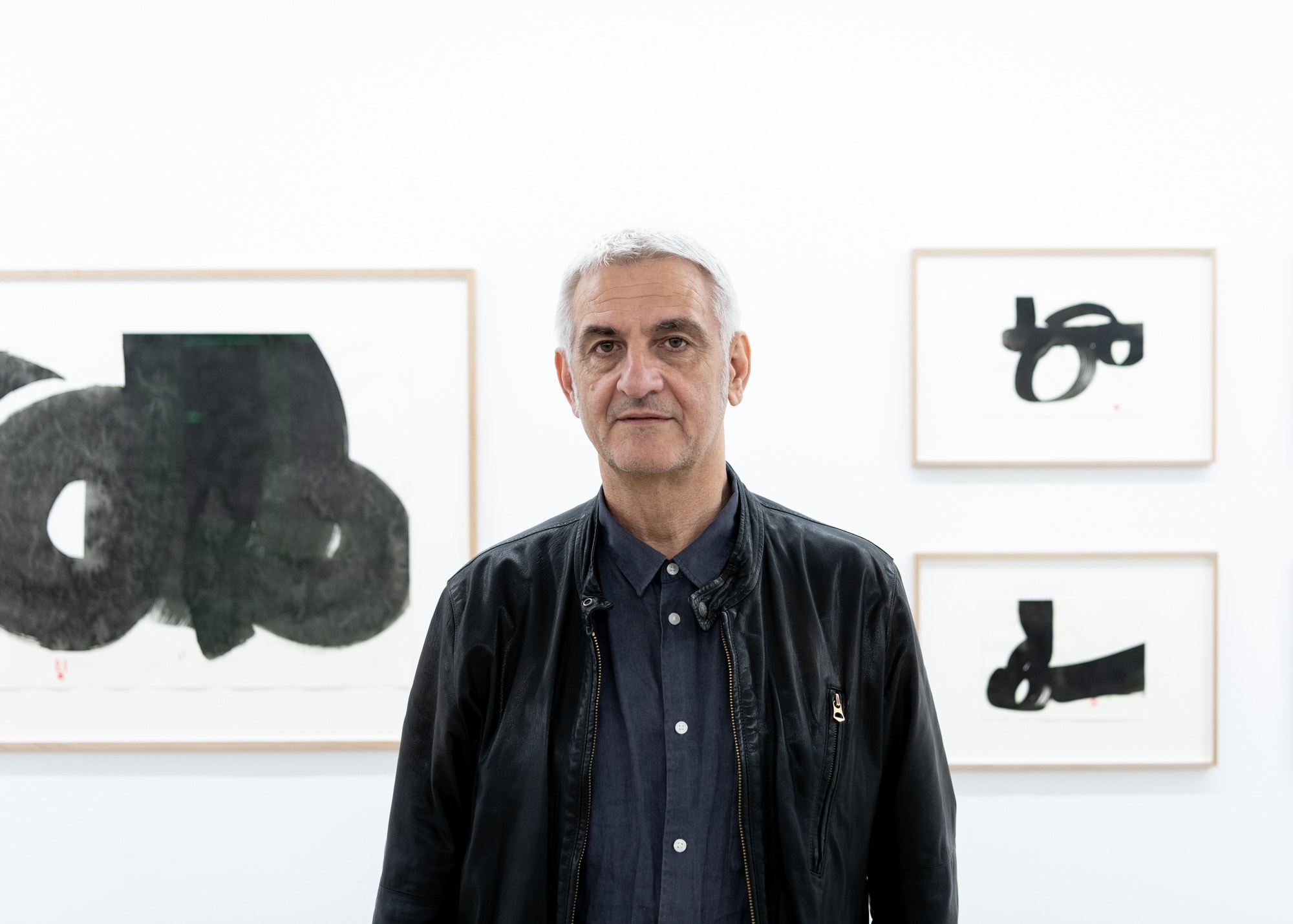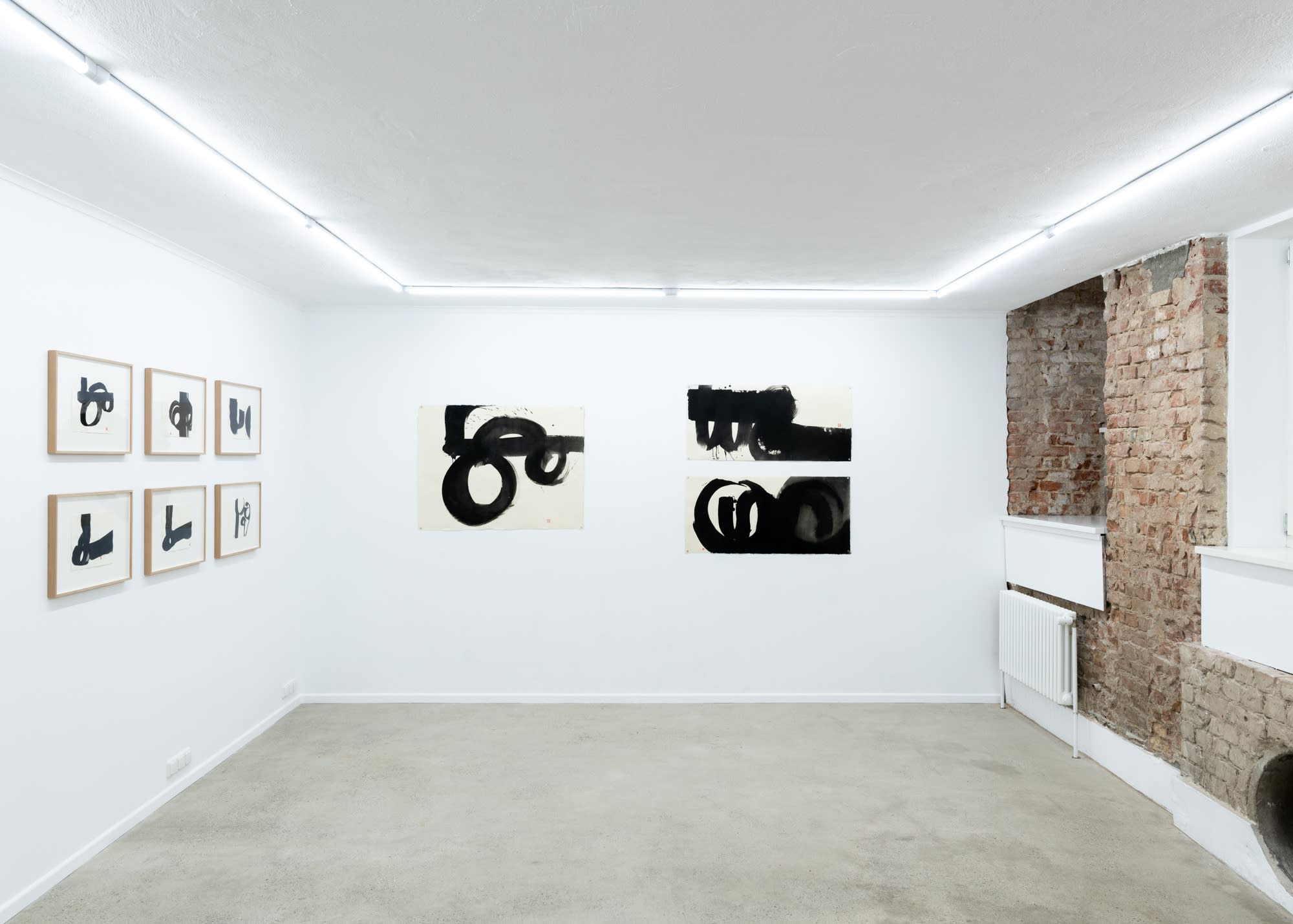
Saša Pančić. Photo credit: Nebojša Babić.
Roger Washington: The title of your exhibition, "Membranes," explores the metaphor of membranes as selective barriers that protect and define physically and symbolically. Could you elaborate on how this concept translates into your art and how it challenges viewers to consider hidden layers of reality?
Saša Pančić: The exhibition's title, "Membranes," has symbolic meaning derived from the artwork's language - its flatness and imaginary depth. I have always been fascinated by the creation of the physical world; why do certain forms in nature have this specific look? On the other hand, for me, a painted picture (or drawing) is beyond the concept of representation; it has the essence of a particular language and is the perception of different dimensions and interactions between external and internal, physical and psychological, historical and super-historical.
Installation view: Saša Pančić, Membranes. Courtesy: Ronewa Art Projects, Berlin. Photo: Jeremy Knowles
RW: Your artworks show distinctively organic, gestural brushstrokes that some may draw comparisons to the styles of artists like Nakatani Suisen, Robert Motherwell, and Ellsworth Kelly. Have any of these artists directly influenced your work? If not, please share the artists who have had the most significant impact on shaping your artistic style and explain what aspects of their work have resonated with you.
SP: These black-and-white ink drawings on paper prioritize gestural expression and immediacy. As a young student in 1986, I was strongly influenced by a group exhibition I saw at the Museum of Contemporary Art in Belgrade. The exhibition featured works by Action Painters associated with the Japanese Gutai Art Association.
My journey continued to evolve as I discovered a broader family of artists who shared similar artistic philosophies. These include but are not limited to such artists as Robert Motherwell, Isamu Noguchi, Eduardo Chillida, and Vojin Bakić.
RW: The front side of each of your drawings in the exhibition bears a red ink stamp, your initials, and the number 23. Could you delve into the significance of this marking and its connection to the themes or concepts explored in your artwork?
SP: Throughout the history of art, the combination of black, white, and red colors was used in Chinese and Japanese calligraphy and their painting, then in the historical avant-garde as well as in the Bauhaus movement. All of them, though unconsciously, influenced me as well. However, the red seals (initials of my first and last name) used as visual elements also indicate a specific archival habit, with the additional number 23 as the year of creation of the work. Simply put, the red accents complete the drawing.
Installation view: Saša Pančić, Membranes. Courtesy: Ronewa Art Projects, Berlin. Photo: Jeremy Knowles
RW: The exhibition features three distinct series of monochromatic ink drawings: "Semantic Shadows," "Beyond the Horizon," and "Liminality." Please elaborate on how these three series relate to the exhibition title and describe what sets each series apart.
SP: All drawings were created using ink and wide brushes on three different types of paper: Fabriano cotton paper, silk paper, and handmade Japanese paper. They partly influenced the separate naming of these drawings. It is logical why a series of titles such as "Behind the Horizon," Semantic Shadows," and "Liminality" is brought under the common name "Membranes." It points towards the fluid-unifying space, the permeable surfaces from which the physical world emerges, with the need to name it. Those processes interest me more than the result itself.

Installation view: Saša Pančić, Membranes. Courtesy: Ronewa Art Projects, Berlin. Photo: Jeremy Knowles
RW: Since starting your career as an artist in 1992, you have explored various mediums in art, including paintings, sculptures, and art videos. How has your diverse approach to art contributed to and shaped your development as an artist?
SP: The multi-media artistic experiment I initially embarked on was quite natural. It was the only way to include my creative interests in practice. The legacy of avant-garde and modernism reflected through postmodernism, gave me that possibility. Consistency lies in the primary idea, the artistic imagination, regardless of the medium or material of expression. I found the idea of "walking" through different materializations in different languages while the basic idea holds them together. This approach made me flexible for all the digital spaces we are exposed to through screen images.
BIOGRAPHY

Installation view: Saša Pančić, Membranes. Courtesy: Ronewa Art Projects, Berlin. Photo: Jeremy Knowles
Serbian multimedia artist Saša Pančić engages in a proficient interplay across multiple mediums, from evocative drawings and paintings to the transformative space of sculptures and art videos.
In the present realm of abstraction and minimalism, Pančić's approach presents a poignant dichotomy. While many might perceive these styles as mere aesthetic choices, Pančić grants them agency, using them as tools to probe the essential nature of his subjects. The emphasis is steadfastly on substance, challenging and expanding upon the currency of form.
For Pančić, art operates as a tangible dialogue, brimming with lucid ideas and profound emotions. His artworks traverse numerous themes, from the overtly external environments to the profoundly personal internal worlds and from historical reflections to ruminations on impending futures.
Pančić has participated in solo and group exhibitions in his home country of Serbia and internationally, including Novi Sad, Podgorica, Poreč, Varna, Sofia, Bucurest, Chiang Mai (Thailand), Ningbo (China), and Ronewa Art Projects, Berlin. His works are held in private and public collections, including "The Wienere" Collection, Belgrade, Serbia; Luciano Benetton Collection, Italy; Collection of the Arte Gallery, Belgrade, Serbia; Collection of the Gallery Thalberg, Zurich, Switzerland; Collection of the Gallery Lamusee, Tokyo.
Ronewa Art Projects
Potsdamer Strasse 91
10785 Berlin
contact@ronewa.com
Tel: +49 30 77 37 87 30
Opening hours:
Tuesday – Saturday
12:00 – 18:00
*or by appointment
Join our mailing list:
Newsletter



 Installation view: Saša Pančić, Membranes. Courtesy: Ronewa Art Projects, Berlin. Photo: Jeremy Knowles
Installation view: Saša Pančić, Membranes. Courtesy: Ronewa Art Projects, Berlin. Photo: Jeremy Knowles

Add a comment